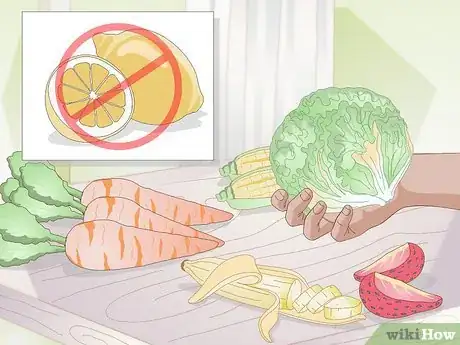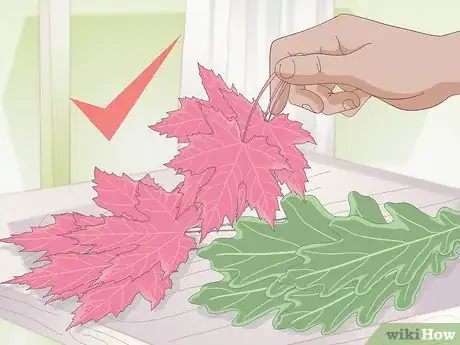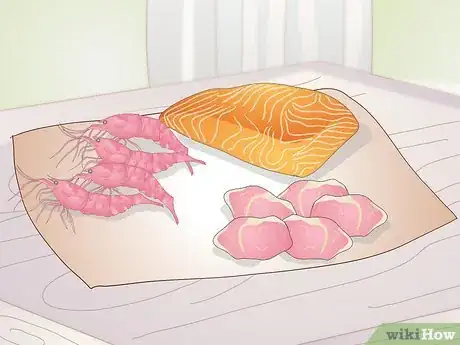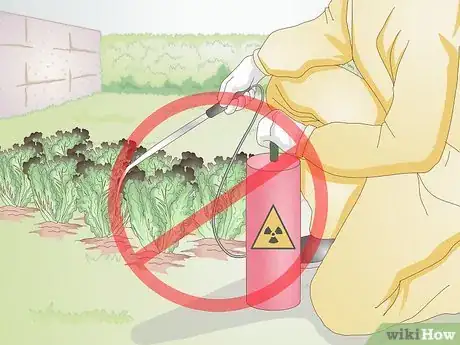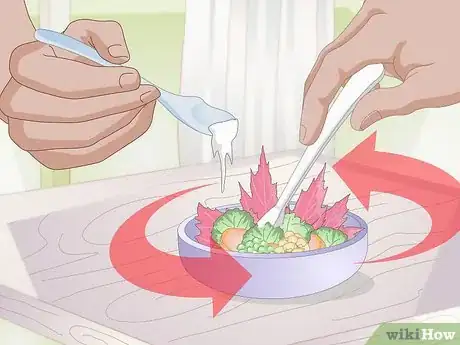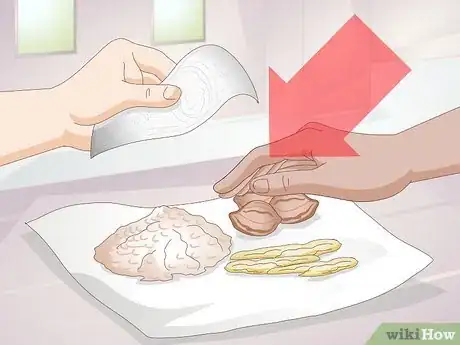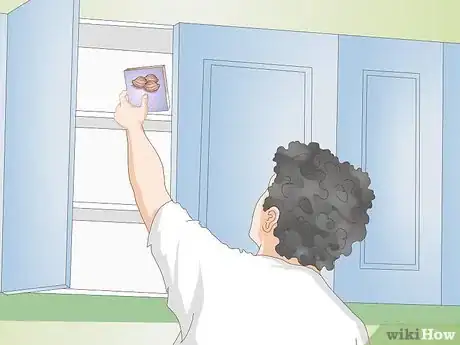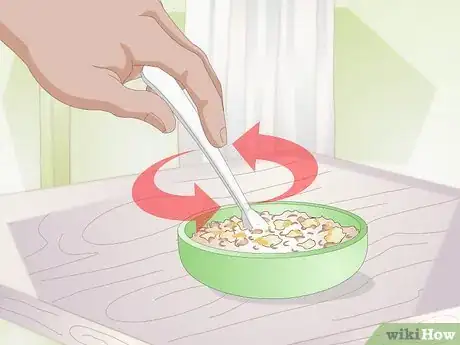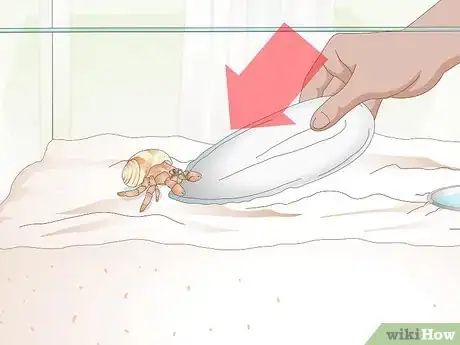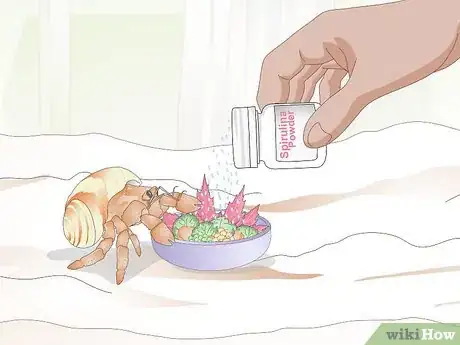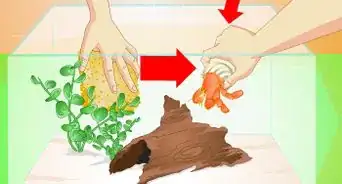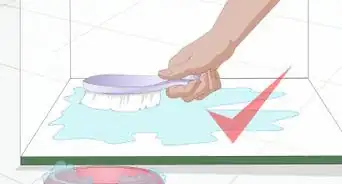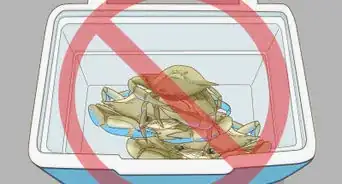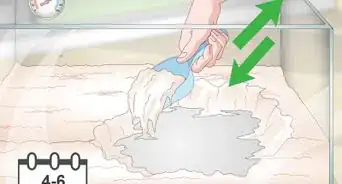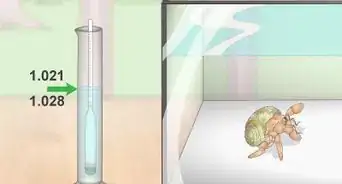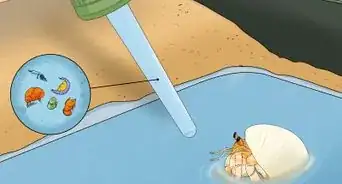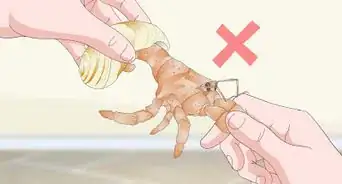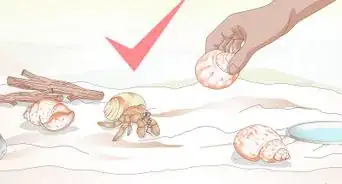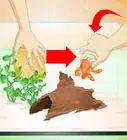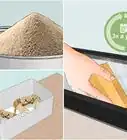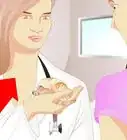This article was co-authored by Pippa Elliott, MRCVS. Dr. Elliott, BVMS, MRCVS is a veterinarian with over 30 years of experience in veterinary surgery and companion animal practice. She graduated from the University of Glasgow in 1987 with a degree in veterinary medicine and surgery. She has worked at the same animal clinic in her hometown for over 20 years.
wikiHow marks an article as reader-approved once it receives enough positive feedback. In this case, several readers have written to tell us that this article was helpful to them, earning it our reader-approved status.
This article has been viewed 59,448 times.
Hermit crabs make wonderful pets and companions. You can treat your hermit crab well and make him feel loved by preparing fresh, wholesome food for him to eat. Homemade foods are superior to processed and packaged pellet foods. Just like you, your hermit crab will enjoy fresh fruits and veggies, dry goods (like nuts and grains), and other treats.
Steps
Preparing Food From Scratch
-
1Purchase a variety of fruits and veggies. Visit your local grocery store or farmers market and purchase some fresh fruits and vegetables. (Organic produce is best, if possible.) Pick up some lettuce, kiwifruit, banana, bell peppers, grapes, strawberries, blueberries, or any other fruits and veggies you like. Wash them thoroughly, and cut them up into very small pieces.[1]
- Hermit crabs don't like the taste of citrus fruits like lemon and lime and will probably not eat them.
- They also don't like herbs (peppermint, rosemary).
- They tend to avoid "Prunus fruits" or "stone fruits" (cherries, apricots, plums).
-
2Harvest some leaves and bark. If you have oak trees or red maple trees in your area, these trees provide a great source of nutrition for your hermit crab. Harvest a few oak leaves and some oak bark, or some red maple leaves. Be sure to wash your leaves and bark in dechlorinated water.[2]
- Oak trees have leaves with a "lobe and sinus" pattern.
- Maple leaves have three "fingers" (think of the Canadian flag).
- Oak trees drop acorns, while maple trees drop "helicopters."
Advertisement -
3Add some form of protein. In addition to fruit and veggies, it is crucial for hermit crabs to have some form of protein everyday. Your crab may enjoy cooked lean beef, chicken, salmon, or shrimp. Or you can add dried plankton, krill or any other dried sea creatures (available at most pet stores).[3]
- Be sure the protein you provide has not been seasoned with spices or table salt.
-
4Avoid pesticides. Your hermit crab can eat almost any kind of vegetables or fruit, but they are very sensitive to fertilizers and pesticides. Whenever possible, you should seek out organic produce and untreated leaves/bark. If this is not possible, all produce should be washed thoroughly in dechlorinated water.[4]
-
5Mix everything together. Combine a ¼ cup of chopped fruits and veggies with ¼ cup of protein. Add a few leaves or bark (if possible), and 1 tsp. of sea salt. Mix everything together. Serve 1/3 of this mix to your hermit crab each night and refrigerate the rest.[5]
- Note that sea salt is different from conventional table salt. Sea salt contains natural, unrefined minerals that are healthy for your crab, whereas table salt does not.
Making a Snack From Dry Goods
-
1Visit your local health food store. If you’d like to make your hermit crab a snack (in addition to his daily meal), it is as easy as a quick trip to your local health food store. You will want a store with a bulk section (such as Whole Foods), this way, you can buy just a little bit of each item, and it will be inexpensive for you.[6]
-
2Purchase a variety of foods. You can make a hermit crab snack from a mix of unsalted nuts, whole grains, unsweetened dried fruits, and seeds. You may also want to include nutritional yeast for added B vitamins. You only need a little bit of each item (1/4 cup or less).[7]
- Nuts: pistachios, walnuts, or almonds.
- Grains: oats, wheat bran, wild rice, or amaranth.
- Dried fruits: mango, goji berries, pineapple, coconut, or raisins.
- Seeds: pumpkin, chia, or sesame.
- Choosing unsalted and unsweetened varieties is very important because table salt and processed sugar can be harmful to your crab.
-
3Look in your pantry. If you do not have access to a health foods bulk section, or if you just want to make the most of what you already have, take a look in your pantry at home. Look for any of the food items above, or for other healthy options.[8]
- Look for oats, granola, whole grain crackers, raisins, or nuts.
- Once again, read labels to watch out for added table salt or sugar.
-
4Mix everything together. Take all the dry foods you have purchased or found in your pantry, and mix them all together. If using granola or whole grain crackers, crumble them up or use crumbs from the bottom of the bag.[9]
- Since these foods are not considered perishable, you can place some of this food in the “crabitat” and allow it stay for 3-4 days, or until your hermit crab finishes it.
Experimenting with Other Foods
-
1Avoid processed foods. When selecting food for your hermit crab, understand that your crab can eat almost any whole, unprocessed food. Food with added table salt and added sugar (such as chips, cookies, or fast food) can have a negative impact on your crab. These foods can cause digestive distress or even illness in your crab. Do not give your crab processed food.[10]
-
2Make some hardboiled eggs. Another favorite source or protein for hermit crabs is hardboiled eggs. This can be served as part of a meal, or as a snack. Be sure to let it cool off quite a bit before offering a hardboiled egg to your crab.[11]
- Simply place eggs in a small pot and cover with water.
- Bring to a boil and let simmer for 8 minutes.
- Some crabs may also enjoy scrambled eggs.
-
3Pop some popcorn. Popcorn is a wholesome food that can be given to your hermit crab as a treat. The healthiest popcorn is air-popped without oil, but any plain popcorn (without butter) can be an enjoyable snack for your hermit crab.[12]
-
4Give your crab cuttlebone. A cuttlebone is the flattened oval internal skeleton of the cuttlefish. Dried cuttlebones can be purchased at pet stores to feed birds, hermit crabs, and other animals. Place a whole cuttlebone in your crab’s tank for him to nibble on, or crush one up and include it in his meal.[13]
-
5Try adding spirulina powder. Spirulina powder is a dense super-food powder made from blue-green algae. This powder can be added to your crab’s food to supplement him with amino acids, protein, iron, and vitamins B, C, D and E.[14]
- Spirulina powder is available at any health food store.
-
6Make sure they have clean water. Provide clean, filtered water for your crab to drink. Additionally, make a saltwater bowl available to him about once a week. You will want to replace the water in the fresh water dish each day to make sure your crab stays healthy.[15]
References
- ↑ https://www.cuteness.com/article/list-hermit-crabs-can-eat
- ↑ http://www.hermit-crabs.com/food.html
- ↑ https://www.cuteness.com/article/list-hermit-crabs-can-eat
- ↑ http://animals.mom.me/list-foods-hermit-crabs-can-eat-2449.html
- ↑ http://www.hermit-crabs.com/food.html
- ↑ http://animals.mom.me/list-foods-hermit-crabs-can-eat-2449.html
- ↑ http://animals.mom.me/list-foods-hermit-crabs-can-eat-2449.html
- ↑ http://animals.mom.me/list-foods-hermit-crabs-can-eat-2449.html
- ↑ http://animals.mom.me/list-foods-hermit-crabs-can-eat-2449.html
- ↑ http://www.hermit-crabs.com/food.html
- ↑ https://www.cuteness.com/article/list-hermit-crabs-can-eat
- ↑ https://www.cuteness.com/article/list-hermit-crabs-can-eat
- ↑ http://www.hermit-crabs.com/food.html
- ↑ https://draxe.com/spirulina-benefits/
- ↑ https://www.cuteness.com/article/list-hermit-crabs-can-eat
